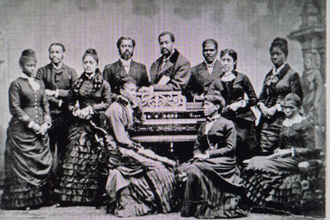Sacred and Profane: Aubrey Beardsley at Tate Britain

The Achieving of the Sangreal 1892
Aubrey Beardsley's fin de siècle black and white prints are variously divine, delicious and decadent, and at times all three at once.
Beardsley is the arch-purveyor of a countercultural queer aesthetic. He died at the age of just 25, yet in his short life produced a vast output of work.
A visionary artist, possessing an exquisite, sometimes cruel and satiric sensibility - Beardsley said, 'If I am not grotesque I am nothing' - he was a predecessor of Andy Warhol's 'freaks' and Lady Gaga's 'Little Monsters'. Like them, he embraced performative surfaces and play: a shape-shifting fluidity in identity, sexual or otherwise.
Like Oscar Wilde, his great queer contemporary and fellow dandy, Beardsley was celebrated for his playful irreverence, his sense of style and wit. And like Wilde, too, he converted to Catholicism when close to death.
Tate Britain's superb exhibition documents Beardsley's astonishing output, sets him in his social and artistic context, and along the way provides glimpses of the artist's openness to Catholic culture which hint at his journey towards an eventual conversion to the faith. The exhibition also demonstrates the richness and range of the work.
Born in 1872 into a petty-bourgeois family, Beardsley was diagnosed with tuberculosis from the age of seven. As an artist, he knew his life would be short, and he determined to fill his few working years with 'the immediate echo of a great notoriety'.
Early in 1889, he started clerking in London and spent many lunch hours reading in Jones and Evans bookshop. The proprietor Frederick Evans took the famous 'gargoyle portrait' photograph of Beardsley, so called because his head in hands profile evoked Viollet-le-Duc's 'Stryge' sculpture looking down from on high at Notre Dame de Paris. (The photo also bears a certain felicitous resemblance to the actor Kenneth Williams, in some ways a kindred spirit.)
In December 1889, Beardsley had his first severe episodes of lung haemorrhage, caused by his tuberculosis. He was off work for 18 months. He did not draw much but read avidly, especially French novels.
From 1891 there followed seven great years of prodigious artistic creation. The artist Edward Burne-Jones, the first of many distinguished supporters and mentors, was struck by the talent on display in the young man's portfolio of drawings and encouraged him to attend the Westminster School of Art.
The frieze-like composition The Procession of Joan of Arc (1892) highlights Beardsley's life-long enthusiasm for the Renaissance painter Andrea de Mantegna. He had seen his celebrated series The Triumphs of Caesar at Hampton Court Palace.
In the same year, Beardsley was commissioned to illustrate Thomas Malory's Le Morte Darthur, a 15th-century version of the legends of King Arthur, by the publisher JM Dent who planned a substantial edition in the style of William Morris's Kelmscott Press books.
Dent had proclaimed The Achieving of the Sangreal, the sample drawing that secured the commission, 'a masterpiece'. The picture focuses on the crucial episode where Sir Percival kneels in prayer before the Holy Grail (the Sangreal - the receptacle of Christ's blood) which is 'borne by a maiden' - with angel's wings in Beardsley's rendering. Both these works contain a focused solemnity and anticipate a private reverence and yearning after the numinous residing in the artist's soul.
In less than two years, Beardsley produced 353 drawings and received £250 over the course of this commission. This freed him to leave his hated job as a clerk and to focus on art-making. Beardsley gradually grew weary of this immense project. Subversive details started to appear in his drawings, and incongruous characters such as mermaids and satyrs.
The artist quickly adapted his style to suit the photographic line block printing process, which uniquely could reproduce both the finest of lines and large, flat areas of black.
Wilde's symbolist play Salomé, and Beardsley's accompanying illustrations, both created a sensation, focusing as they did on sex, death and desire. The artist had the playwright's own head appear in many satiric guises, most memorably as an effeminate and puffy moon. But of course it was the demand for John the Baptist's head on a platter, identified as a quasi-Eucharistic signifier in the Middle Ages, which was the source and summit of both play and Beardsley's images. Gustave Moreau's watercolour The Apparition had made a strong impression on Wilde at the 1876 Paris Salon Exhibition. It represents the bloody vision of John the Baptist's head appearing while Salomé dances for Herod. It featured, too, in Joris-Karl Huysmans's 1884 novel A Rebours (Against Nature). Wilde could quote at length from this 'bible' of decadence. (Though like Wilde and Beardsley, Huysmans too converted to a contemplative Catholicism. The exhibition also shows a charming, playful sketch of 'Oscar Wilde at Work' on the play by Beardsley. Most prominent among all the books for such a project is a 'Family Bible'.)
Inspired by the Paris poster revolution, and notably the posters of Toulouse-Lautrec, Beardsley proceeded to design his own. He understood the centrality of mass-produced, often outdoor, advertising and transience in the modern world, saying: 'Beauty has laid siege to the city'.
In 1894, Beardsley became art editor of The Yellow Book, a magazine that became the most iconic publication of the decade. Its distinctive appearance was deliberately risqué, recalling the yellow wrappers of popular French 'erotic' novels. Beardsley's bold drawings gave the magazine its avant-garde and decadent reputation. With each volume, his notoriety increased. In the third, Beardsley included his portrait of Mantegna but attributed it to the fictional artist Philip Broughton. He revelled in the wide praise for the work even from critics who had voiced disdain for his art.
However, Beardsley's meteoric success was short-lived. In 1895, Oscar Wilde was prosecuted for 'gross indecency'. As the scandal tore through London, the backlash focused upon the notorious magazine and its audacious art editor. Beardsley was already connected to Wilde through Salomé. When Wilde was seen at his arrest carrying a yellow book (in fact a French novel, not The Yellow Book), the link between the author and the artist was damning. Outraged crowds broke the windows of the publishing house. John Lane, the publisher, succumbed to pressure and sacked Beardsley.
In the three years left of his life, Beardsley became an itinerant, spending much time in Europe, and particularly in France. Despite grave bouts of ever-increasing illness, his output remained astonishing and he became art editor of the short-lived Savoy magazine praised by WB Yeats for valiantly waging 'warfare on the British public [increasingly conservative, socially and aesthetically] at a time when we had all against us'. The ensuing illustrations of Aristophanes' Lysistrata, and Juvenal's misogynistic Sixth Satire were his most outrageous yet, reserved for a private clientele.
In March 1897, Beardsley was received into the Catholic Church.
On 7th March 1898, nine days before his early death from tuberculosis, Aubrey Beardsley wrote an impassioned letter to his publisher Leonard Smithers from the Hôtel Cosmopoli-tain in Menton on the French Riviera. It read 'Jesus is our Lord and Judge. Dear friend, I implore you to destroy all copies of Lysistrata and bad drawings. … By all that is holy - all obscene drawings. Aubrey Beardsley. In my death agony.' Fortunately for us, Smithers did not comply.
The exhibition shows a photograph of Beardsley in this same hotel room some months earlier. He wears an elegant suit and is engrossed in a book. A large crucifix is on the desk in front of him and on the wall are prints of the religious works of his beloved Mantegna. He died with rosary beads and crucifix to hand.
In an 1891 letter to his schoolfriend GF Scotson-Clark, Beardsley includes a poem he composed:
The lights are shining dimly round about,
The Path is dark, I cannot see ahead;
And so I go as one perplexed with doubt,
Nor guessing where my footsteps may be led.
The wind is high, the rain falls heavily,
The strongest heart may well admit a fear,
For there are wrecks on land as well as sea
E'en though the haven may be very near.
The night is dark and strength seems failing fast
Though on my journey I but late set out.
And who can tell where the way leads at last?
Would that the lights shone clearer round about!
Beardsley ultimately made a decision to embrace the Catholic faith. His life was cruelly cut short by 'the galloping consumption'. Whatever the doubts and darkness, it seems Newman's 'kindly light' led him to that resolve even 'amid the circling gloom', and he found his Path and eventual haven.
Beardsley was a magpie in his art, fluid and playful. His catholic, eclectic tastes proceeded to inspire later avant garde countercultures and experimental advertising.
It is worth remembering too that for many radical activists and artists, particularly in a predominantly Protestant English context, a marginal and often despised Catholicism was profoundly counter-cultural, exotic and subversive. Which is not to doubt the sincerity of these conversions. One of the 'Beardsley circle' on display is the poet John Gray who in his early years had been a protégé of Wilde. Gray also converted and became priest of St Peter's Church, Morningside, Edinburgh. The church was built by his wealthy life-long companion Marc-André Raffalovich, another convert and writer, notably about homosexuality, who provided Beardsley's principal financial support in his last years.
Tate Britain's superb and super-substantial exhibition gives fascinating glimpses of Beardsley's burgeoning and developing Catholic sensibility.
At Tate Britain until 20th September.
For tickets more information, see: www.tate.org.uk/whats-on/tate-britain/exhibition/aubrey-beardsley


















